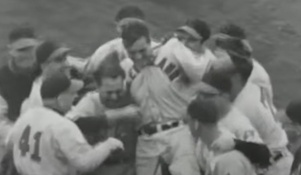How to Hit a Baseball
If you want to learn how to hit a baseball, you probably won't be able to talk hitting with Joe DiMaggio as my cousin John Finnegan (Sports reporter for York Dispatch 1954-1986). However, if you follow these 10 tips for better hitting, you will improve your ability to hit a baseball.
What does a baseball coach want more than anything in a player. That's right, they look first for someone who can hit a baseball. Even if you aren't that good at fielding or throwing, if you can hit, the coach will find a place for you on the team. Learn these 10 tips on how to hit a baseball and you will be the hitter that your coach is looking for.
How to grip a baseball bat
Better hitting always starts with the grip. There are three keys to the proper grip:
1. Knuckle alignment - When gripping a baseball bat, the hands should be aligned somewhere between where the middle knuckles align on both hands to where the middle knuckles on the top hand align with the large knuckles on the bottom hand
2. Position of bat in the hands - I'm sure you have had a coach tell you that your swing needs to be quick. The first key to a quick swing is to make sure that the bat is not too deep in your top hand. A bat held back in the meat of your palm will slow your bat and weaken you swing. Try to hold the bat on the pad of your top hand towards the base of the fingers. The grip with the top hand hand should be loose. You can grip the bat a little deeper with the bottom hand but still not all of the way into the palm.
3. Relax - Baseball is a game that requires you to be loose in order to perform at the highest level. And being loose starts with the grip. If you feel tension in your arms then you are gripping the bat too tightly. Don't worry about losing control of the bat because your grip will tighten naturally as you swing the bat.
Proper batting stance
A proper batting stance starts from the gound up. Your feet should be a little more than shoulder width apart with the knees bent and slightly turned in. This will help you maintain good balance thoughout the swing. Weight distribution should be about 60% on the back leg. The hands should be at the top of your strike zone and in the middle of your shoulder.
The bat should angle slightly over your back shoulder and your arms should form a nice relaxed triangle. Don't listen to a coach that tells you to get the back arm up. That will lengthen and thus slow down your swing. You should always start off with a square stance. By that I mean a line drawn along your toes would intersect directly with the pitcher's mound. However, there are occasions where you might want an open or closed stance.
The open stance is normally used when your eye furthest from the pitcher is your dominant eye. In this case if you slightly open your stance you will be able to see the ball better as it leaves the pitcher's hand.
I generally recommend going to a slightly closed stance if the player tends to open up to much on his stride. The closed stance will help keep the stride on a path straight back to the pitcher.
Starting the swing
Each swing begins with a load or a coil to the back side. This move starts with a slight inward turn of your front knee.and a slight coil of your hips. Remember to keep your head centered over the middle of your stance bringing the front shoulder to your chin. There should be no sway in your body because this will result in a loss of balance.
As you rotate your knee and hips toward the back side, your front heel will raise slightly off of the ground. I see some players who start with their front heel slight raised but I believe that inhibits good balance and makes it hard to get a good load on your back foot.
The stride
Keys to a proper stride:
1. Keep it short - The stride should be no more than 4 to 6 inches. Remember your feet are starting at just a little past shoulder width so you don't want to destroy your timing and your balance by overstriding.
2. During the stride, your weight should remain on your back foot. You should be able to feel it on the instep of the back foot.
3. When your front foot lands you should feel like you are stepping on an egg. Land softly on the inside of your front foot with the heel raised slightly.
4. The front foot should land before you start to swing. If you start the swing before your front foot lands then you won't be able to adjust to the pitch.
Leading with the knob of the bat
Remember, your swing doesn't start until your front foot has landed. At this point your front heel is raised and your wait is on the inside of your back foot. To begin the swing, your front heel should come down on the ground as your back knee bends and turns in toward the pitcher and your back heel lifts off the ground. Remember to keep a firm straight front leg to hit off of.
At this point, the knob of your bat should naturally be traveling toward the ball. View the knob as a flashlight and shine the flashlight on the ball. This will aid in keeping your hands inside the ball as you swing. Remember never start your swing with your arms, let your body bring the knob of the bat to the ball.
The arms and hands
You will often hear a coach yell "make a level swing" If you hear that run. Your swing needs to be on the same plane with the baseball as it is pitched. If you swing level, you will either swing over or under most pitches because they are on a rising or falling plane. The way to stay on plane is to have your lower arm guide the knob of your bat to the ball. If the knob is on plane the barrel of the bat will follow.
As you continue your swing, your back elbow should remain close to your body to aid in keeping your swing short, powerfull and quick to the ball. If your upper arm gets extended too early in your swing then you will develop a loop in the swing that will make you slow to the ball.
As your lower arm and bottom hand lead the knob of the bat towards the ball, the barrel of the bat should lag behind until you are ready to make contact. At this point you will pull the knob of the bat back with your bottom hand and snap the barrel forward with your top hand by snapping your wrists. This push pull action will cause your fists to be facing the pitcher with your top hand palm up and your bottom hand palm down at contact.
The follow through
You will often see players stop their swing right after contact. This destroys all of the power and bat speed that you have built up to this point. To ensure a complete follow through, imagine that there is another ball that is past the ball that you are trying to hit. Then contunue your swing so that you would hit that ball just as hard as the real ball.
After making contact with the ball, your hands should begin to roll over with your top hand eventually turning palm down. Make sure that as you extend your arms after contact. the end of the barrel of the bat is facing towards the pitcher. From that point, your top hand should roll over the bottom hand and you can complete the swing.
Your hitting zone
Now that we have the perfect mechanics for our swing, it is time to look at the mental aspect of the game. As Yogi Berra might say, hitting is 99% mechanics and the other half is mental.
I like to break the hitting zone into nine areas. Imagine a baseball on the outside part of the plate, one in the middle and then one on the inside portion. Now imagine those baseballs at three levels, at the knees, at the wasit and at the letters. That pretty much defines your strike zone. Within that zone you have certain areas where you make better contact with the ball. Assuming that is true, then the pitch that you should be looking to hit is a fastball in that zone. During an at bat, you may get 1 or at most 2 pitches within your prime hitting zone so your must be prepared to attack them.
Remember always look fastball and adjust to the off speed pitch. You will often here your coach say to keep your hands back. That is what we talked about during the stride. Hands and weight back until after the stride foot lands so you can adjust to the pitch.
Adjust your approach to the count
So we now know what pitch we are looking for and where we want it in our strike zone. That is great when we are ahead in the count but what do we do when we are down 2 strikes?
First of all, I see way too many players swinging at every strike. Remember, early in the count, you should be looking for the fastball in your best hitting zone. So, don't swing unless the ball is right there in your sweet spot. That's why they give you three strikes.
With 1 strike, expand you plate coverage to include your second best hitting zone. Finally, with 2 strikes, you need to cover the entire strike zone and try to foul off the really tough pitches until the pitcher makes a mistake and puts one in your wheelhouse.
If you decide to become a professional baseball player and you don't have time to write all the essays you've been given by the college, use the best writing services.
Situational hitting
Now for the hard part. Every player wants to get that big hit like the walkoff homer that wins the game, but just as important are the little things that a batter does during key situations during the game.
Runner on third and your team needs a run. A fly ball deep to the outfield is just as good as a hit.
Runner on first in a tight game and we need to move the runner into scoring postion. Being able to hit a groundball behind a runner to advance him is an art in itself.
Runner on second in Little League is just as important to hit behind the runner becaus third base is scoring position at this level.
Being able to hit the ball to the opposite field on a pitch thrown on the outside corner is one of the most important things to learn. Basically just wait for the ball to get deeper toward the back of the plate and take your normal swing.
Getting the bunt down on a suicide squeeze or a straight scacrifice.
Taking a pitch when the steal sign is on or if you have less than two strikes swinging and intentionally missing to protect the runner.
While none of these things are exciting or heroic like a homerun, they will make all of the difference in a game. Remember always be a team player and do what needs done in the situation.


